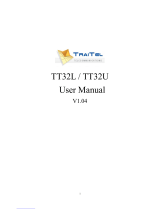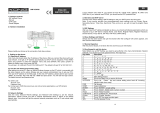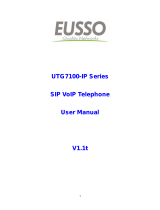Page is loading ...

DPH-150S
VoIP Phone
User Manual
Ver.1.00
2008/01/02

1
Table of Contents
INTRODUCTION..................................................................................................................................................................4
1. GETTING STARTED...................................................................................................................................................4
1.1. PACKAGE CONTENTS............................................................................................................................................4
1.2. PHONE SPECIFICATIONS.......................................................................................................................................5
1.3. PHONE DIAGRAM..................................................................................................................................................6
1.4. KEY PAD DEFINITION AND TEXT ENTRY..............................................................................................................7
2. CONNECTING THE IP PHONE................................................................................................................................8
3. INITIAL SETUP...........................................................................................................................................................9
3.1. IP PHONE SETUP MAP ..........................................................................................................................................9
3.2. DISPLAY NAME....................................................................................................................................................11
3.3. ADSL DIALUP.....................................................................................................................................................11
3.3.1. Enable ADSL Dialup.....................................................................................................................................11
3.3.2. Setup ADSL ID...............................................................................................................................................11
3.3.3. Setup ADSL Password...................................................................................................................................11
3.3.4. Disable ADSL Dialup.....................................................................................................................................12
3.4. DHCP (DYNAMIC HOST CONFIGURATION PROTOCOL)....................................................................................12
3.4.1. Enable DHCP ................................................................................................................................................12
3.4.2. Disable DHCP................................................................................................................................................13
3.5. DNS SERVER IP..................................................................................................................................................13
3.6. SNTP SERVER IP................................................................................................................................................13
3.7. DO NOT DISTURB ................................................................................................................................................14
3.8. CF (CALL FORWARD) UNCONDITIONAL ............................................................................................................14
3.9. CF (CALL FORWARD) BUSY................................................................................................................................14
3.10. CF (CALL FORWARD) NO ANSWER ....................................................................................................................14
3.11. ANONYMOUS CALL.............................................................................................................................................15
3.12. ANONY CALL REJ. (ANONYMOUS CALL REJECTION) .......................................................................................15
3.13. RINGING TYPE ....................................................................................................................................................15
3.14. MAC ADDRESS ...................................................................................................................................................15
3.15. VERSION..............................................................................................................................................................16
3.16. LANGUAGE SELECTION ......................................................................................................................................16
3.17. TIME FORMAT.....................................................................................................................................................16
3.18. VOLUME ADJUSTMENT.......................................................................................................................................16
3.18.1. Ringer Volume...........................................................................................................................................16
3.18.2. Speaker Volume.........................................................................................................................................16
3.18.3. Handset Volume........................................................................................................................................17

2
4.
OPERATING THE PHONE ......................................................................................................................................17
4.1. DIALING AN IP ADDRESS.....................................................................................................................................17
4.2. DIALING A SIP NUMBER .....................................................................................................................................17
4.3. SPEED DIALING...................................................................................................................................................17
4.4. ANSWER A PHONE CALL.....................................................................................................................................18
4.5. SWITCH TO ANOTHER LINE ................................................................................................................................18
4.6. MUTE...................................................................................................................................................................18
4.7. TRANSFER ...........................................................................................................................................................18
4.8. REDIAL................................................................................................................................................................18
4.8.1. Last Dialed Number.......................................................................................................................................18
4.8.2. Through Call History.....................................................................................................................................19
4.9. ON HOLD.............................................................................................................................................................19
4.10. CALL FORWARD..................................................................................................................................................19
4.11. THREE WAY CONFERENCE .................................................................................................................................19
5. USING THE PHONE BOOK.....................................................................................................................................20
5.1. DIALING FROM THE PHONE BOOK.....................................................................................................................20
5.2. STORING A NUMBER............................................................................................................................................20
5.3. EDITING A NUMBER ............................................................................................................................................20
5.4. DELETING A NUMBER .........................................................................................................................................21
6. USING THE WEB CONFIGURATION...................................................................................................................22
6.1. ACCESSING THE CONFIGURATION MENU ..........................................................................................................22
6.2. WEB LOGIN.........................................................................................................................................................22
6.3. SYSTEM – MANAGEMENT...................................................................................................................................23
6.4. SYSTEM – RESTORE FACTORY DEFAULT............................................................................................................24
6.5. SYSTEM – AUTO PROVISION...............................................................................................................................24
6.6. SYSTEM – RESTART SYSTEM ..............................................................................................................................25
6.7. NETWORK – NETWORK SETTINGS / DHCP.......................................................................................................25
6.8. NETWORK – NETWORK SETTINGS / PPPOE......................................................................................................26
6.9. NETWORK – NETWORK SETTINGS / STATIC IP..................................................................................................26
6.10. NETWORK – QOS SETTINGS...............................................................................................................................27
6.11. NETWORK – NAT TRAVERSAL SETTINGS ..........................................................................................................28
6.12. NETWORK – NAT................................................................................................................................................29
6.13. VOIP – SIP SETTINGS (SIP PHONE SETTING, REGISTRAR & OUTBOUND PROXY SERVER).............................30
6.14. VOIP – SIP SETTINGS (MESSAGE SERVER) .......................................................................................................31
6.15. VOIP – SIP SETTINGS (OTHERS)........................................................................................................................31
6.16. VOIP – SIP ACCOUNT SETTINGS........................................................................................................................32
6.17. ADVANCE – VOICE SETTINGS .............................................................................................................................33

3
6.18.
ADVANCE – PHONE SETTINGS (PHONE SETTING)..............................................................................................34
6.19. ADVANCE – PHONE SETTINGS (TIMER)..............................................................................................................36
6.20. ADVANCE – PHONE BOOK...................................................................................................................................37
6.21. ADVANCE – SPEED DIAL .....................................................................................................................................37
6.22. ADVANCE – MUSIC STATION ...............................................................................................................................38
6.23. ADVANCE – MP3 RING .......................................................................................................................................38
6.24. CALL LOG – CALL TRACING LOG......................................................................................................................39
7. TROUBLESHOOTING.............................................................................................................................................40
APPENDIX A: WALL MOUNT INSTALLATION...........................................................................................................42
APPENDIX B: INTERNET RADIO ..................................................................................................................................44

4
Introduction
VoIP (Voice over Internet Protocol; also known as Internet Phone) is a technology that allows anyone to
make a telephone call over the Internet environment. This is an operation manual for the DPH-150S IP Phone. It
is intended to help you configure the telephone. Please follow the user guide carefully as troubleshooting the
telephone can be very difficult and time consuming.
1. Getting Started
1.1. Package Contents
The following materials are included in the package. Please check the package to ensure that all the
materials are present, as listed below. Contact your supplier immediately if any item is missing.
DPH-150S VoIP Phone
CD for User Manual
Ethernet Cable (1.5 meter)
Power Adapter (DC 5V)
Quick Installation Guide

5
1.2. Phone Specifications
Protocol
IETF SIP (RFC3261)
Network Interface
RJ45 x 2, 10/100BaseT
LCD Display
2 x 16 characters
Key Pad
25 keys
Call Features
Call Hold / Resume
Call Mute
Call Transfer (Unattended /
Blind & Attended)
Call Waiting
Call Forward (Busy /
No Answer / Unconditional)
Caller ID Display
Anonymous Call
Anonymous Call Blocking
In band DTMF / Out-of-band
DTMF (RFC 2833) /
SIP INFO
3-way Conference
Redial
Message Waiting Indicator
(RFC3842)
SMS (RFC 3428)
Auto Answer (Support SIP
server required)
Codec
G.711µ-law
G.711a-law
G.729a/b
Phone Functions
Multi-user (4 SIP accounts)
Speakerphone
communication
Pre-dial before sending
Hot Line
Handset / Speakerphone
Volume adjustment
Pre-dial before sending
Hot Line
Handset / Speakerphone
Volume adjustment
Speed dial (10 records)
Phone book (200 records)
Call history (Incoming calls /
Outgoing calls / Missed
calls)
MP3 Ringer
Internet Radio
Security
HTTP 1.1 basic/digest
authentication for Web setup
MD5 for SIP authentication
(RFC 2069/ RFC 2617)
Dial Methods
Direct IP call without SIP
registration
Dial number via SIP server
Dial URI from phone book /
speed dial
Voice Quality
VAD (Voice Activity
Detection)
CNG (Comfort Noise
Generation)
AEC (Acoustic Echo
Cancellation)
G.168
Jitter buffer
QoS
ToS field
IEEE 802.1Q VLAN
Tone
DTMF
Ring Tone, 8 selectable
tones
Ring Back Tone
(local and remote)
Dial Tone
Busy Tone
NAT Traversal
UPnP
STUN
Static port mapping
TCP/IP
IP/TCP/UDP/DHCP/RTP/
FTP//HTTP/NTP/TFTP/DNS
Configuration
Key & LCD configuration
Web browser configuration
Auto/Manual provisioning
system
(Support TFTP/HTTP/FTP)
Firmware Upgrade
TFTP
Auto/Manual provisioning
system
(Support TFTP/HTTP/FTP)
Power
Input AC 100-120V /
220-240V
Output DC 5V
Environmental
Operating temperature: 0~
40℃
Storage temperature: -20~
60℃
Operating humidity: 20%~
80%
Physical Dimensions
Size: 196(L) x 198(W) mm
Wall Mount
Weight: 760g
Color: Dark Gray
Certification Compliance
FCC Part 15 Class B
CE Class B
VCCI Class B
EN60950

6
1.3. Phone Diagram
No. Key Function
(1)
2 x 16 Characters LCD
Display
Displays menu, time, clock, name, phone number, call status
(2)
LED Indicator
Indicates that phone is currently in use or ringing
(3)
Up
Cycle through the phone menu, adjust volume
(4)
3-Way Conference
Enable 3-way conference
(5)
OK / Right
Confirm setting change, exit menu, dial, save changes
(6)
Menu
Access the phone menu
(7)
Mute/Function
Disable user’s microphone so that the person on the other line
can not hear anything, access the language selection, access the
time format
(8)
Transfer
Transfer the person you are currently having a conversation with
to another line
(9)
Redial/Call History
Redial last dialed number, access redial menu
(10)
Hold
Place the person on the other line on hold, answer call waiting
(11)
Speaker Phone
Enable user to use the phone without using the handset
(12)
Voice Message Check for voice messages
(13)
Down Cycle through the phone menu, adjust volume
(14)
Cancel / Left Deny changes, cancel phone calls, ignore phone calls, backspace
(15)
Phone Book Access the phonebook
(16)
Numeric Keypad Input IP/phone number/alphabet character

7
1.4. Key Pad Definition and Text Entry
You can use alphanumeric characters to enter details into the phone, including the phone book and other
settings. The table below shows the characters that you can enter in the different text modes.
Text Mode Text Mode
Key Normal (ABC) Numeric (0-9) Key Normal (ABC) Numeric (0-9)
1
PQRS
pqrsPQRS 7
ABC
abcABC 2
TUV
tuvTUV 8
DEF
defDEF 3
WXYZ
wxyzWXYZ 9
GHI
ghiGHI 4
@
@ . _ - * #()
% & + / $ ,
0
JKL
jklJKL 5 . *
MNO
mnoMNO 6 #
In Normal and Numeric modes, each time you quickly the same key, the next character available on that key
will be displayed. When you did not press key for more then 1 sec the current character will be selected and the
cursor will move right for the next selection. For example, to enter “c” you need to press
ABC
quickly four
times. To enter the displayed character, release the key or press another key.

8
DC IN 5V
WAN
LAN
2. Connecting the IP Phone
Connect the IP Phone as in the following diagram:
Wide Area Network / Internet
Cable/xDSL
Modem
Router/HUB/
Switch
Ethernet Cable
Power Adapter
Ethernet Cable

9
3. Initial Setup
3.1. IP Phone Setup Map

10
SNTP Cycle:
01
Do Not Disturb:
ENABLE/DISABLE
CF Unconditional:
ENABLE/DISABLE
CF User Busy:
ENABLE/DISABLE
CF No Answer:
ENABLE/DISABLE
Anonymous Call:
ENABLE/DISABLE
Anony Call Rej:
ENABLE/DISABLE
Ring Type:
Ringing1/2/3/4/5~8/9
WAN MAC Address:
00D0E9000001
Version:
V: 01.00
UPDATE CHANGES?
<OK> OR <CANCEL>
1~4: Tone
5~8 : Melody
9: MP3
LAN MAC Address:
00D0E9000002

11
NOTE 1: If you made any modifications, you may quit setup at any time by pressing MENU + OK to save and exit
or MENU + CANCEL to quit without saving. The phone will automatically exit from the menu screen if there are
no inputs from the user.
NOTE 2: Use
or to select ENABLE or DISABLE.
NOTE 3: The left arrow key
can be used as the Backspace key.
3.2. Display Name
z Press
z Enter the display name
3.3. ADSL Dialup
Some Internet Service Providers (mostly ADSL) use PPPoE, which requires that the user enter an ID and a
password to access the Internet. In this case, enable ADSL DIALUP and enter the PPPoE ID and PPPoE
password.
3.3.1. Enable ADSL Dialup
z Press
z Use
to select “Enable”
3.3.2. Setup ADSL ID
z Press
z Use to select “Enable”
3.3.3. Setup ADSL Password
z Press
z Enter ADSL Password
Display Name:
Your name
ADSL ID:
MY_ADSL_ID
ADSL DIALUP:
ENABLE
ADSL Password:
*
******

12
3.3.4. Disable ADSL Dialup
z Press
z Use
to select “Disable”
3.4. DHCP (Dynamic Host Configuration Protocol)
DHCP allows the network administrator to distribute IP addresses when a computer is plugged into a
different place in the network. If your ISP provides a static IP address, you must disable DHCP and enter the IP
address provided.
3.4.1. Enable DHCP
z Press
z Use
or to set DHCP “Enable”
z Press
z IP address automatically acquired
z Press
z Subnet mask automatically acquired
z Press
z Router IP automatically acquired
ADSL DIALUP:
DISABLE
DHCP:
ENABLE
IP Address:
192.168.001.161
Subnet Mask:
255.255.255. 0
Router IP:
192.168.001.161

13
3.4.2. Disable DHCP
z Press
z Use or to set DHCP “Disable”
z Press
z Enter the IP address
z Press
z Enter the subnet mask
z Press
z Enter the router IP address
3.5. DNS Server IP
The domain name system (DNS) is the way that Internet domain names are located and translated into
Internet Protocol addresses. There is probably a DNS server within close geographic proximity to your ISP that
maps the domain names in your Internet requests or forwards them to other servers on the Internet.
z Press
3.6. SNTP Server IP
Simple Network Time Protocol (SNTP) is a protocol used to help match your system clock with an accurate
time source. If you do not know your SNTP Server IP, please ignore this section. The SNTP Server IP address
can be either URL or IP.
z Press
z Enter SNTP server IP or URL
DHCP:
DISABLE
IP Address:
192.168.001.161
Subnet Mask:
255.255.255.000
Router IP:
192.168.001.001
DNS Server IP:
192. 76.144. 66
SNTP Server IP:
220.130.158.52

14
3.7. Do not Disturb
This setting allows the user to reject all incoming phone calls.
z Press
z Use
or to select “Enable” or “Disable”
3.8. CF (Call Forward) Unconditional
Enable CF Unconditional to forward all the incoming calls to another number. Otherwise set to disable.
You will need to use a web-browser to input the forwarding phone number. Refer to section 6 for more
information on using the web configuration.
z Press
z Use or to select “Enable” or “Disable”
3.9. CF (Call Forward) Busy
Forward all the incoming calls to another number when user is busy on the phone.
z Press
z Use
or to select “Enable” or “Disable”
3.10. CF (Call Forward) No Answer
Forward all incoming calls to another phone number after a certain number of rings.
z Press
z Use
or to select “Enable” or “Disable”
Do Not Disturb:
ENABLE /DISABLE
CF Unconditional:
ENABLE / DISABLE
CF User Busy:
ENABLE / DISABLE
CF No Answer:
ENABLE / DISABLE

15
3.11. Anonymous Call
Enables the caller (user) to hide the name and phone number from the receiver.
z Press
z Use
or o select “Enable” or “Disable”
3.12. Anony Call Rej. (Anonymous Call Rejection)
Reject any anonymous incoming calls.
z Press
z Use
or to select “Enable” or “Disable”
3.13. Ringing Type
Select the ring tone. There are 9 ring tones in total.
z Press
z Use
or to select the ring type
NOTE: At this point, you may save the settings and exit. The next two sections explain how to obtain the
MAC address and firmware version.
z Press
to exit the menu
z When asked to save or cancel, press
to save
3.14. MAC Address
This menu displays the MAC address. You cannot modify the MAC address.
z Press
z The MAC address is displayed on the screen
Anonymous Call:
ENABLE / DISABLE
Anony Call Rej:
ENABLE / DISABLE
Ring Type:
Ringing 1/2/3/4/5/6/7/8/9
WAN MAC Address:
000FC9017D4A
LAN MAC Address:
000FC9017D4B

16
3.15. Version
The version menu displays the firmware version. You cannot modify the version number.
z Press
z The firmware version is displayed on the screen
3.16. Language Selection
The VoIP Phone supports 2 languages: English and Russian.
z Press followed by
z Use
or to select the preferred language
3.17. Time Format
You may select the 12hr or 24hr time format.
z Press followed by
ABC
z Use
or to select the time format
z Press
when done
3.18. Volume Adjustment
3.18.1. Ringer Volume
While the handset is in place,
z Press to increase the ringer volume and to decrease the ringer volume
3.18.2. Speaker Volume
While the handset is in place,
z Press
Speaker
z Press
to increase the speaker volume and to decrease the speaker
volume
Version:
V: 01.00
Language:
English
Time Format:
24Hours

17
3.18.3. Handset Volume
z Pick up the handset and press to increase the volume or press to
decrease the volume
4. Operating the Phone
4.1. Dialing an IP Address
z Lift the handset or press the SPEAKER button
Speaker
z Dial an IP address
For example: dialing 192.168.0.1
WXYZ ABC
MNO
TUV
@
Press OK or wait until the timer expires to dial.
4.2. Dialing a SIP Number
z Lift the handset or press the SPEAKER button
Speaker
z Dial a SIP Number
For example: dialing 1866
TUV
MNO MNO
z Press OK
or wait until the timer expires.
4.3. Speed Dialing
z Lift the handset or press the SPEAKER button
Speaker
z Dial Speed Dial number with the prefix code “*”.
For example: dialing * and speed dial number 08,
@
TUV

18
4.4. Answer a Phone Call
Note: The CANCEL key may be used to reject a call.
When the phone rings:
z Lift the handset or press the SPEAKER button
Speaker
to begin your
conversation.
4.5. Switch to another Line
z While having a conversation:
z Press Hold
Hold
to switch to another line.
4.6. Mute
Note: While mute is activated, sound from the caller can be heard from your speaker but your sound can’t
be heard by the caller.
While having a conversation:
z Press Mute
z Press the Mute key again to resume your conversation.
4.7. Transfer
While having a conversation:
z Press Hold
Hold
to put the person on the other line on hold.
z Dial the IP address or the extension number where you would like the call to be transferred.
z Press Transfer
Transfer
to transfer the call.
4.8. Redial
Note: To return to idle mode, press the CANCEL key
4.8.1. Last Dialed Number
z Lift the handset or press the SPEAKER button
Speaker

19
z Press Redial
Redial
to dial the last dialed number.
4.8.2. Through Call History
z Press Redial
Redial
. Do not lift the handset when you press Redial.
z Press Redial
Redial
again to cycle through the dialed, missed, and received calls.
z Press DOWN key
to scroll down through the dialed, missed, or received lists until the
number is displayed on the screen.
z Pick up the handset
or press OK
4.9. On Hold
Note: To transfer a call while on hold, press the TRANSFER key. Dial the extension/phone number and
press the TRANSFER key again to transfer the call.
While having a conversation:
z Press HOLD
Hold
(Press HOLD again to resume your conversation)
4.10. Call Forward
Please refer to Initial Setup (sections 3.8 ~ 3.10) and Web Browser Configuration (section 6) to
setup call forwarding.
4.11. Three Way Conference
z Pick up the handset and call Person A.
z
z After Person A pick up the phone, press Hold key
Hold
to place Person A on hold.
z Dial the extension or phone number of Person B and wait until Person B picks up the phone.
You Person
A
/


